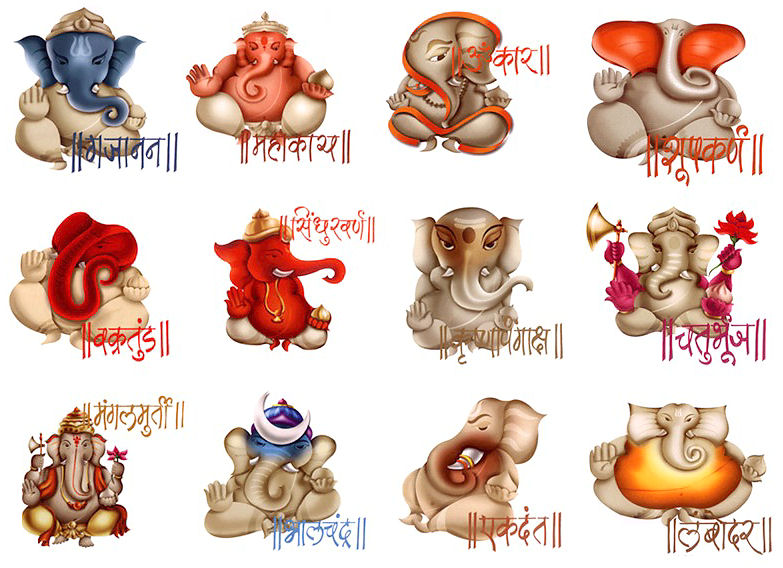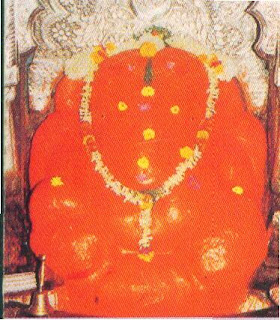Showing posts with label Video. Show all posts
Showing posts with label Video. Show all posts
Monday, 5 November 2012
Thursday, 27 September 2012
Ashtavinayaka Darshan
06:16
ashtavinayak, ashtavinayak darshan, ashtavinayak package, ashtavinayak songs, ashtavinayak tour, images, photo, Video, Wallpapers
No comments
Ashtavinayaka literally means "eight Ganeshas" in Sanskrit. Ganesha is the Hindu deity of obstacles, unity, prosperity and learning. The term refers to eight Ganeshas. Ashtavinayaka yatra refers to a pilgrimage to the eight Hindu temples in Maharashtra state of India that house eight distinct idols of Ganesha, in a pre-ascertained sequence.
Distance of Ashtavinayak temples from pune
On Pune - Solapur road
Pune - Theur (Shree Chintamani) 25 Kms
Pune - Siddhatek (Shree Siddhivinayak) 98 Kms
Pune - Moregaon (Shree Moreshwar) 64 Kms
On Pune - Nagar road
Pune - Ranjangaon (Shree Mahaganapati) 50 Kms
On Pune - Nashik road
Pune - Ozar (Shree Vighnahar) 85 Kms
Pune - Lenyandri (Shree Girijatmaj) 94 Kms
On Pune - Mumbai road
Pune - Mahad (Shree Varadavinayak) 83 Kms
Pune - Pali (Shree Ballaleshwar) 110 Kms
Ashtavinayak yatra as it should been done
According to Shastra you should take darshan in following order.
Day one: Start from Pune
1. The Moreshwar Temple, Moregaon (Pune-Hadaspsar-Loni-Chaufula-Supa-Moregaon)
2. The Siddhivinayak Temple, Siddhatek (Moregaon-Supa-Chaufula-Daund-Siddhatek)
3. The Ballaleshwar Temple, Pali (Siddhatek-Daund-Chaufula-Loni-Pune-Lonawala-Khopoli-Pali)
4. The Varadavinayak Temple, Mahad (Pali-Khopoli-Mahad)
Back to Pune (Mahad-Khopoli-Lonawala-Pune)
Day two:Start from Pune
5. The Chintamani Temple, Theur (Pune-Hadaspsar-Loni-Theur)
6. The Girijatmaj Temple, Lenyandri (Theur-(Nagar Road)Lonikand -Ranjangaon-Malthan-Ahemadabad Fata-Manchar-Narayangaon-Junnar-Lenyandri)
This road from Ranjangaon is exactly opposite the Mahaganapati Temple. You will take Mahaganapati darshan while coming back from Ozar.
7. The Vighnahar Temple, Ozar (Lenyandri-Ozar)
Bad road but not too far.
8. The Mahaganapati Temple, Ranjangaon (Narayangaon-Manchar-Ahemadabad Fata-Malthan-Ranjangaon)
again visit 1.The Moreshwar Temple, Moregaon to complete your Ashtavinayak Yatra.(Ranjangaon-Chaufula-Supa-Moregaon)
Back to Pune (Moregaon-Supa-Chaufula-Loni-Hadapsar-Pune)
Ashtavinayak yatra Shortest route from Pune
Day One: Start from Pune
1. The Chintamani Temple, Theur
2. The Moreshwar Temple, Moregaon
3. The Siddhivinayak Temple, Siddhatek
4. The Mahaganapati Temple, Ranjangaon
You can come back to Pune or Stay at Bhakta Niwas at Ranjangaon or Ozar
Day Two
5. The Vighnahar Temple, Ozar
6. The Girijatmaj Temple, Lenyandri
7. The Ballaleshwar Temple, Pali
8. The Varadavinayak Temple, Mahad
Back to Pune
Ashtavinayak yatra Shortest route from Mumbai
Day One: Start from Mumbai
1. The Ballaleshwar Temple, Pali
2. The Varadavinayak Temple, Mahad
3. The Girijatmaj Temple, Lenyandri
4. The Vighnahar Temple, Ozar
Stay at bhakt niwas at Ozar. Soon VIP bhakta niwas will start at Ozar
Day Two:Start from Ozar
5. The Mahaganapati Temple, Ranjangaon
6. The Siddhivinayak Temple, Siddhatek
7. The Moreshwar Temple, Moregaon
8. The Chintamani Temple, Theur
Back to Mumbai
Wednesday, 12 September 2012
Ganesh Chaturthi Celebration
06:09
arti, bhajan, chalisa, day, festival, ganesh, ganesh chaturthi, ganesh history, ganpati, god, goddess, mantra, saints, slokas, stotras, Video, wallpaper
2 comments
Ganesh Chaturthi is celebrated on the birthday of Lord Ganesh (Ganesha), the god of wisdom and prosperity on the fourth day of the moons bright fortnight, or period from new moon in the lunar month of Bhadrapada. The celebration of Ganesh Chaturthi continue for five, seven, or ten days. Some even stretch it to twenty one days, but ten the most popularly celebrated. In the tradition of the right hand path the first day is the most important. In the left hand path tradition the final day is most important.
Ganesha is the god of wisdom and prosperity and is invoked before the beginning of any auspicious work by the Hindus. It is believed that for the fulfillment of one's desires, his blessing is absolutely necessary. According to the mythology, he is the son of Shiva and Parvati, brother of Kartikeya - the general of the gods, Lakshmi - the goddess of wealth and Saraswati-the goddess of learning. There are numerous stories in Hindu mythology, associated with the birth of this elephant-headed god, whose vehicle is the Mooshak or rat and who loves Modaks (droplet shaped Indian sweet).
Legend has it that Parvati created Ganesha out of the sandalwood dough that she used for her bath and breathed life into him. Letting him stand guard at the door she went to have her bath. When her husband, Shiva returned, the child who had never seen him stopped him. Shiva severed the head of the child and entered his house. Parvati, learning that her son was dead, was distraught and asked Shiva to revive him. Shiva cut off the head of an elephant and fixed it on the body of Ganesha.
Another tale tells of how one day the Gods decided to choose their leader and a race was to be held between the brothers- Kartikeya and Ganesh. Whoever took three rounds of the earth first would be made the Ganaadhipati or the leader. Kartikeya seated on a peacock as his vehicle, started off for the test. Ganesh was given a rat, which moved swiftly. Ganesh realised that the test was not easy, but he would not disobey his father. He reverently paid obeisance to his parents and went around them three times and thus completed the test before Kartikeya. He said, " my parents pervade the whole universe and going around them, is more than going round the earth." Everybody was pleasantly surprised to hear Ganesha's logic and intelligence and hence he came to be known as the Ganaadhipati or leader, now referred to as Ganpati.
There is also a story behind the symbolic snake, rat and the singular tusk. During one of his birthdays, His mother, Parvati, cooked for him twenty-one types of delicious food and a lot of sweet porridge. Ganesha ate so much that even his big belly could not contain it. Mounting his little mouse, he embarked on his nightly rounds. His mouse suddenly stumbled upon seeing a huge snake. To adjust His belly, Ganesha put the snake on as a belt around his stomach. All of a sudden, he heard laughter emanating form the sky.
He looked up and saw the moon mocking him. Ganesha infuriated, broke off one of his tusks and hurled it at the moon. Parvati, seeing this, immediately cursed the moon that whoever looks at it on Ganesh Chaturthi will be accused of a wrong doing. The symbology behind the mouse and snake and Ganesha's big belly and its relationship to the moon on his birthday is highly philosophic. The whole cosmos is known to be the belly of Ganesha. Parvati is the primordial energy. The seven realms above, seven realms below and seven oceans, are inside the cosmic belly of Ganesha, held together by the cosmic energy (kundalini ) symbolized as a huge snake which Ganesha ties around Him. The mouse is nothing but our ego. Ganesha, using the mouse as a vehicle, exemplifies the need to control our ego. One who has controlled the ego has Ganesha consciousness or God-consciousness.
Sunday, 9 September 2012
Ganesh Images
06:21
arti, bhajan, chalisa, day, festival, ganesh, ganpati, god, goddess, mantra, saints, slokas, stotras, Video, wallpaper
1 comment
Aum shri ganeshaya namah
This mantra is usually taught to children for their good education. It increases their memory power, and they become successful in their examinations. Of course, people of any age may use this mantra when taking courses in a school or university, and for success in attaining their degree.
Tuesday, 7 August 2012
Shri Krishna
03:19
2012, celebration, dahi handi songs free download, gopal, kanhaiya, kano, kishan, krishna bhajan, krishna janmashtami, lalo, lord shri krishna, photos, shri krishna, Video, Wallpapers
No comments
Once upon a time there lived an evil, wicked and ambitious king by name of Kamsa in Mathura. He plundered the kingdom left and right and lawlessness prevailed in his state. On one of the days a heavenly prophecy from the sky came and echoed, “Kamsa! Your end is near! The eighth son of Devaki, your sister, will be the one responsible for your death.” Kamsa was enraged beyond control and imprisoned Devaki, his sister and Vasudeva her husband. Then he killed every child of the couple as they were born. But just the midnight when the eighth child was born, the skies roared and Lord Vishnu advised Vasudeva to take the child across the river Yamuna to the other side to the village of Gokul and exchange with the daughter of Yashoda in Gokul, who was born on the same day. Vasudeva accordingly put the child in a basket, and as he went out the doors of the prison parted for him as if in a magic. The river parted into two to allow for Vasudeva to cross. Vasudeva then crossed into Gokul and exchanged his son with the daughter of Yashoda who was born the same day and came back. The baby uttered cries which awakened Kamsa, and then happily he went to the prison chamber and snatched the girl baby and as he lifted her in the air, the baby, who was an incarnation of the Devi herself, laughed in glee “Kamsa, your real enemy is still alive. The son of Devaki is alive and well and will come back to kill you”, and then disappeared. Kamsa was outraged beyond wits and started a killing spree of all boys at that age in his kingdom. It was a terror outbreak.
Krishna led a very pampered and amorous life in the Gokul, along side thousands of gopikaas, the cowherdesses who were all entralled at his beauty and were thrilled whenever he played the flute. There are numerous playful instances of Krishna, playing mischief with the gopikaas including breaking their butter pots. Many a poets, literarians have described these amorous and mischievious acts as Raas-Lila of Krishna. Among all the gopikaas, one Radha was special to Krishna. There are numerous amorous tales of Radha and Krishna together. Krishna is also known to be a very mischievious child who annoyed Yashoda a lot. A lot of dohas (poems) described by Mirabai, an ardent devotee of Krishna, are very popular which describe the naughty acts of Krishna. Among them the one titled “Maiya Mori Main nahi makhan khayo” is an all-time favourite. It describes the excuses which Krishna gives to his mother yashoda explaining that he was not responsible for stealing of the butter from the gopikaas.
Krishna incarnated in this world to eliminate evil elements from this world. There are numerous tales of his bravery since his childhood. Many of the stories are related to the attempts by Kamsa, to kill Krishna after Kamsa came to know that Krishna was in Gokul alive. Some of the tales are given below
As Krishna grew older he left the heavenly Gokul, and the idyllic life alongside Gopis, to go and kill Kamsa. He killed Kamsa, and then settled in Dwaraka along with his brother Balram and learnt the traditional arts of fighting including archery. He arbitrated in the fight between the Pandavas and Kauravas in Mahabharata. During the war he is well known for his monologue to Arjuna on the battlefield, which is together termed as the Bhagvad Gita. There are many stories of Krishna, starting from his childhood to his death including his role in Mahabarata war, his rule over Dwaraka, his childhood amorous acts with gopikaas including Radha, his winning of wives like Satyabhama etc.
Friday, 29 June 2012
Subscribe to:
Comments (Atom)














































